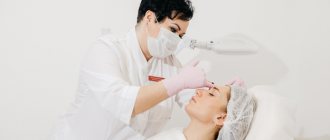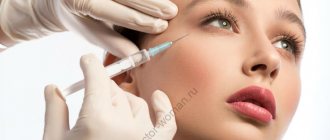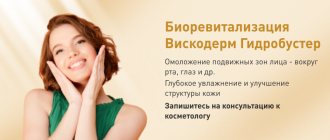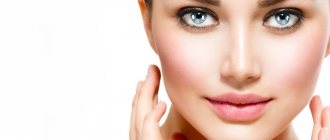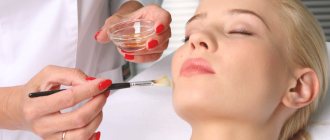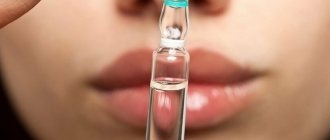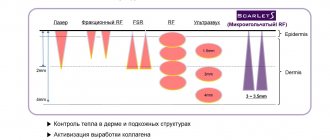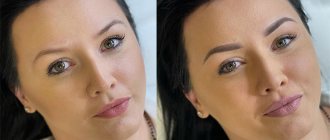In 2015, the Hyalual Switzerland Institute created and introduced to the cosmetic market a drug based on sodium hyaluronate and a salt of succinic acid - sodium succinate.
Hyaluronic acid is found in human nervous, connective and epithelial tissues. Succinic acid is also a product of human activity and takes an active part in metabolic processes. The combination of these two acids provides powerful effects:
- anti-inflammatory;
- antioxidant;
- moisturizing;
- restorative;
- enhancing microcirculation and metabolism in tissues;
- stimulating the synthesis of collagen and elastin.
Hyalual is a modern “elixir of youth” that promotes intensive skin restoration for a long time, making it fresh, radiant, flawless.
What is hyaluronic biorevitalization of the face?
The beauty salon offers various procedures for skin restoration and rejuvenation. This can be mesotherapy, chemical and enzymatic peeling and much more. In addition, biorevitalization has become very popular today. What is the technique and why is it needed?
This is the intradermal injection of a hyaluronic acid substance into certain points, for which a syringe is used - a special injection device that makes manipulations less painful and more precise, and the distribution of the substance is uniform. In addition, stimulation factors can be used. Ultrasound, laser, current, cold exposure, magnetic waves, etc. are used as the latter.
But the main active component in all cases remains hyaluronic acid, which binds moisture, ensuring the desired arrangement of chains of protein molecules in the skin, which are known as elastin and collagen fibers. After the procedures, there is a noticeable improvement in the epidermis, and a pronounced rejuvenation effect.
Cosmetological techniques that can make the skin younger and more beautiful are becoming increasingly in demand.
What are these miracles of modern cosmetology? What effect will be after the procedures?
To begin with, it makes sense to examine the term “biorevitalization” itself, which has roots in Latin and is translated as “return to life.” “Bio” means “natural”, “re” means return, “vita” means “life”.
Isn't that what we want when we try to turn back time by any means possible? The beauty industry offers women an original, reliable solution to not only stop time and ensure high-quality prevention of skin changes associated with aging, but also get rid of existing wrinkles and defects, restore radiance, tone, firmness and elasticity.
Biorevitalization: the essence of the method
So what exactly is this method? This is an aesthetic procedure that rejuvenates the skin, during which hyaluronic acid is injected into the skin layers.
Let's explain everything in detail.
At the age of ± 25 years, changes occur in the female body. Many substances that are designed to provide the necessary processes begin to be produced more slowly. Especially such age-related changes affect organs and systems that interact with the environment more than others.
The skin is the largest of these, and there are many different processes going on in it continuously. Hyaluronic acid is part of the intercellular fluid; it is responsible for the required amount of moisture in it, as well as collagen and elastin. Thanks to the latter and their sufficient quantity, the face, neck and décolleté areas, and hands look young, toned and fresh.
Accordingly, the biorevitalization procedure, by delivering the required amount of hyaluronic acid, can stop aging, smooth out wrinkles, make the skin healthy, giving it beauty. And this is not a miracle at all, but the possibilities of modern cosmetology.
What to expect from the procedure
Redermalization starts the processes of rejuvenation and hydration in the skin, affecting all aging processes and eliminating them. What noticeable changes are taking place? First of all, the skin becomes elastic and tightened, sagging disappears. This is especially true for the area around the eyes, because it is no secret that with age, the delicate skin of the eyelids dries out and loses its elasticity. A preparation such as Hyalual makes the face unusually smooth and velvety. Biorevitalization, patient reviews of which are freely available, removes small expression wrinkles and prevents their further occurrence. This is confirmed by numerous patients. Salts of succinic acid included in the drug help improve blood circulation and, accordingly, change complexion in a positive direction. In addition, the redermalization procedure also affects age spots, making them less noticeable.
Advantages of biorevitalization
If you compare biorevitalization with other aesthetic and surgical methods, you can find a number of advantages:
- minimum pain during injection sessions;
- During the procedures, the integrity of the skin is not compromised, and the patient does not experience additional discomfort;
- sessions are highly effective and give quick results, which are noticeable after the first sessions;
- the recovery period is very short or completely absent;
- the procedure has a minimal number of side effects and special contraindications.
Moreover, biorevitalization is indicated even for very young people for preventive purposes in order to prevent premature fading and the appearance of wrinkles.
Indications
If traditional methods (creams, serums) do not help or do not give the desired effect, this may well become a direct indication for a course of sessions.
Biorevitalization affects the skin in a certain way, so there is a list of the most common indications for the procedures. Here they are:
- dehydration and dry skin;
- changes in skin condition associated with age;
- reduced turgor and inelasticity of the skin;
- unclear facial contour;
- rosacea manifestations;
- pore expansion;
- scars, scars, stretch marks;
- dull complexion;
- negative influence of environmental factors, profession, certain habits;
- restoration of the dermis after laser resurfacing, chemical peeling, surgical interventions;
- spasmodic phenomena in the muscles associated with a lack of vitamins.
As you can see, the procedure is universal; it can be used to solve many different aesthetic problems, but not all. When poor skin condition is caused by systemic diseases of internal organs, treatment should begin from the root cause.
Why is capillary mesotherapy needed?
The term means puncturing the vessels of the face and cervical-collar area in order to stimulate lymph outflow and improve blood microcirculation before biorevitalization. This reduces the swelling of subcutaneous fatty tissue and the volume of soft tissue, which ultimately enhances the effect of the rejuvenating procedure.
Capillary mesotherapy is desirable in the following cases:
- with severe swelling of the face;
- severe ptosis, that is, sagging skin;
- rosacea (transillumination of blood vessels);
- bright age-related changes after 45 years.
The injection is done with vascular preparations, starting from the cervical-collar area, gradually moving to the area of the earlobes, sternomastoid muscle, clavicles, and submandibular area. Then continue along the facial massage lines. For patients with dry skin and fine wrinkles, 1–2 procedures are sufficient. For deformational type of aging and over 45 years of age, 4–5 procedures will be required.
Contraindications
In general, the procedure is safe, but there are still contraindications:
- individual intolerance to the components used in biorevitalization;
- skin diseases and chronic diseases in the acute stage;
- oncology of all types;
- poor blood clotting;
- inflammation in the areas of the skin where the procedure is planned;
- the period when a woman is pregnant or breastfeeding;
- viruses, infections;
- diseases associated with dysfunction of the immune system;
- herpes;
- predisposition to scar formation.
In addition, laser procedures, manipulations using current, sound, and magnetic waves are not recommended for patients with heart disease.
How does the session work?
The preparatory process is similar to any preparation for the introduction of hyaluronic acid into the skin layers and includes diet, limiting sports and other types of physical activity, strengthening blood vessels, and taking antiviral drugs as a preventative measure.
The sessions themselves are also standard and differ little from similar procedures.
You should not buy into advanced techniques, techniques with the addition of new stages, or, on the contrary, truncated courses. This will most likely turn out to be a publicity stunt that violates the rules.
The preparatory stage includes:
- studying the anamnesis, identifying contraindications;
- skin diagnostics and identification of affected areas;
- selection of specific means and type of procedure.
After this you need:
- cleanse your face and remove makeup;
- treat the desired areas with an antiseptic solution;
- perform preliminary marking;
- apply the selected drug;
- carry out a hardware or manual procedure.
If the injection method is chosen, the areas are additionally treated with an anesthetic to relieve pain.
Depending on the area and the chosen method, the procedure can last from 15 minutes to an hour and a half.
At the end of the session, do the following:
- apply products that have a calming effect and at the same time consolidate the result;
- evaluate the effect and give recommendations for further care.
Please note: biorevitalization is not a one-time procedure, but a set of sessions. The preventive course usually consists of 3 procedures at intervals of ± 1 month. If the course is therapeutic, then, as a rule, the specialist individually selects the number of sessions depending on the condition of the skin and indications.
Reviews from cosmetologists about the procedure
Since biorevitalization is a modern and affordable procedure, its results are constantly discussed and commented on by many cosmetologists. Thousands of studies have been conducted, during which it was found that redermalization is a truly useful procedure that does not cause harm to the body.
In addition, this drug is successfully used to treat joints and is called “Hyalual-Arthro”. Instructions for use, price, reviews and effectiveness of use were studied by the Kyiv National Medical Institute. During the studies, it was found that the drug is absolutely safe, and the severity of pain in patients is significantly reduced. Those who have already done the procedure claim that biorevitalization is a truly innovative procedure that helps stop skin aging and resume regeneration processes in its layers.
What is the effect of biorevitalization
The results of the sessions are quite predictable. Therefore, if contraindications are taken into account and the rules are followed, there is no need to be afraid.
And the effect could be as follows:
- the skin receives deep hydration during the first session;
- metabolic processes are activated, the epidermis is saturated with useful substances;
- turgor and skin tone improve;
- the elasticity of the skin is restored;
- wrinkles are smoothed out, the facial contour becomes clearer, and the face as a whole becomes younger;
- dark circles under the lower eyelids lighten;
- swelling goes away;
- pigmentation and rosacea symptoms disappear;
- pores narrow, blackheads and pimples disappear;
- scars and scars become invisible.
This is what the patient and others notice immediately after the session. But there is also an effect invisible to the eye, carried out at the cellular level and facilitating the transport of essential nutrients into the deep layers of the skin.
What are the possible complications?
When carrying out biorevitalization using injection and other techniques of introducing the drug into the dermis, the following consequences may occur:
- The skin turns red and swells; As a rule, such symptoms last 2-3 days and pass.
- Bruises appear at the puncture sites - this is also short-lived.
- Allergic reactions are possible, ranging from mild to angioedema.
- Infection can provoke inflammatory processes (suppuration, abscesses, necrosis).
- At points of impact, compactions of fibrous tissue may form.
- Stagnation of lymph can provoke post-traumatic lymphostasis.
- Atrophy of certain areas of the face can also be a complication after the procedure.
In order to avoid serious problems, it is necessary to immediately seek qualified help at the slightest incomprehensible manifestations.
There is another question that deserves attention: on what day of the female cycle is it best to do the procedures? Immediately before the “critical days”, women experience changes in their hormonal levels. This entails increased susceptibility to pain, the appearance of nervousness, and emotional instability. Therefore, the optimal days for sessions are considered to be the days of the cycle, starting from the 14th (that is, two weeks after the end of menstruation) until the onset of the next menstruation.
What is par for the course
The rejuvenation procedure through biorevitalization cannot be called cheap. Moreover, it is not simple. Therefore, you can only trust your face to a salon with a good reputation, where all the necessary conditions have been created and highly professional certified cosmetologists work.
The cost of the course in different regions of the Russian Federation can range from 5 to 7 thousand rubles. Typically, a repeat course involves discounts.
How to care for your skin after the procedure
If you want to quickly restore your face after a course of procedures and prolong the effect as much as possible, do the following:
- provide protection to your face for two days after the session;
- do not use decorative cosmetics;
- use only care products recommended by a cosmetologist;
- if bruises appear, use arnica-based preparations;
- Do not do eyebrow correction for 7 days;
- Do not visit the gym, bathhouse or sauna for a week;
- It is better to forget about the solarium for 2 weeks; you should not expose your skin to the sun;
- Try to avoid alcoholic drinks in the first days after the procedure, as alcohol removes fluid.
After non-injection procedures, playing sports and visiting baths and saunas are acceptable.
What is the difference between biorevitalization and mesotherapy
Modern cosmetology offers many ways to become more beautiful, younger, and improve the condition of the skin. Many patients are lost in so many offers. Therefore, it is important to know the difference.
Here we will talk about how biorevitalization differs from mesotherapy.
Despite the fact that both methods are injectable and involve the introduction of “hyaluronic acid” into various layers of the skin, the difference is precisely in the amount of this main component. If increased doses are used in biorevitalization, then meso-cocktails are used in mesotherapy, where the percentage of hyaluronic acid is much lower, but a large number of other components are present.
What to choose: biorevitalization or mesotherapy?
Biorevitalization gives quick results. The effect is noticeable already on the second day after the first session.
The benefit of the technique is that the skin receives rapid, active hydration, the liquid begins to better retain in its layers, stimulating the production of its own elastin and collagen.
As a rule, additional components are not used during biorevitalization.
Mesotherapy, on the contrary, assumes a cumulative effect and operates with complex compounds containing vitamins, organic acids, minerals, amino acids, extracts of plant and animal origin.
After the first session there are no visible changes, the result appears only after 3-4 visits, but it can be a pleasant shock.
It cannot be said that biorevitalization is better than mesotherapy and vice versa. Each method is good in its own way and solves a certain range of problems. Therefore, to get the best effect, you need to consult with a professional who will assess the situation and give competent recommendations.
Types of procedures within biorevitalization
The concept of “biorevitalization” includes several types of procedures, among which everyone can choose the most suitable one. However, all varieties are guaranteed to provide one consistent effect - they stimulate the production of collagen and elastin, thereby prolonging the youth of the skin.
Many cosmetologists believe that non-injection hardware biorevitalization techniques provide a result similar to chemical peeling - they cleanse the epidermis of dead cells.
Non-injection procedures
Today, non-injection methods, including biorevitalization, are used more and more often.
Their essence lies in the fact that the active substance, in this case hyaluronic acid, is delivered to the skin layers using physical or chemical processes. Among them:
- Cryobiorevitalization, when hyaluronic acid enters the skin under the influence of liquid nitrogen or through the action of low-frequency electrical waves.
- Iontophoresis method - involves the use of a stable galvanic current.
- Magnetophoresis, in which hyaluronic acid is transported into the skin by magnetic waves.
- Oxygen biorevitalization - involves the introduction of a substance into the deep layers of the skin with the help of oxygen.
- Ultraphonophoresis – uses ultrasound vibrations to deliver hyaluronic acid to the desired depth of the dermis.
In addition, cosmetologists use products containing low molecular weight “hyaluronic acid”, which does not require punctures to penetrate the skin.
Injection sessions
During the procedures, the drug is injected deep into the dermis using a syringe with a mini-needle. There are two options for impact here:
- manual administration, which is performed by a doctor using a syringe;
- hardware injections, which are performed using special equipment with attachments.
Both varieties are popular, often used and have their own advantages and disadvantages. When administered manually, errors in dosage and accuracy are possible. Hardware exposure is more precise, but at the same time more aggressive towards the skin.
Biorevitalization using laser
This technique provides an excellent effect and does not violate the integrity of the skin. Hyaluronic acid is strictly dosed into the desired areas using an infrared laser.
The high cost of a session is perhaps the most serious disadvantage of laser biorevitalization. Moreover, to achieve the most stable, long-lasting effect, at least 5 sessions are necessary.
How often should you take the course?
To achieve long-lasting results, it is necessary to regularly resort to biorevitalization. This is due to the fact that our cells are constantly renewed, and in the process of such renewal, hyaluronic acid is broken down. Therefore, cells need nourishment.
For prevention, experts recommend a course of three biorevitalization sessions with an interval of about a month. After 6 months, it is advisable to repeat the course.
If the skin needs more significant help and elimination of existing defects, the number of sessions and the interval between them should be determined by the doctor based on anamnesis and examination of the condition of the skin.
What drugs are used
Biorevitalization courses are very different not only in terms of the principle of influence, but also in the components used. Here are a few of the most popular and in demand: AL-system, Jalucomplex, Teosyal-Meso and Teosyal Pure Sense Redensity, Meso-Wharton P199, Beautelle. This is just a small list of the most commonly used imported products produced in Italy, Switzerland, South Korea, and France. There is also a domestic drug - “Gialripayer 02”.
Before and after photos
Now you know that the effect of biorevitalization can be seen in the mirror almost instantly. Meanwhile, some of the complications that we wrote about above will also be noticeable. Therefore, there is no need to panic. Wait 2-3 days and you will see what the method is really capable of.
Still in doubt? Do you think about the risks that exist even with the safest procedures? Still, if you plan to eventually use one of the rejuvenation methods, biorevitalization will be the safest and most effective.
Price for redermalization Hyalual
The cost depends entirely on the concentration. So, for Hyalual 1.1 the price of the procedure will be about 9 thousand rubles per two milliliters. For the most concentrated Hyalual, the price of the procedure will be around twelve thousand.
Prices:
| Hyalual spr. 1.1% 1.0ml. | 15000,00 | rub |
| Hyalual spr. 1.1% 2.0ml. | 17000,00 | rub |
| Hyalual spr. 1.8% 1.0ml. | 16000,00 | rub |
| Hyalual spr. 1.8% 2.0ml. | 19000,00 | rub |
| Hyalual spr. 2.2% 1.0ml. | 16000,00 | rub |
| Hyalual spr. 2.2% 2.0ml. | 20000,00 | rub |
Make an appointment
Author:
Kolosova Vera Mikhailovna
Cosmetologist, Dermatovenereologist, venereologist
